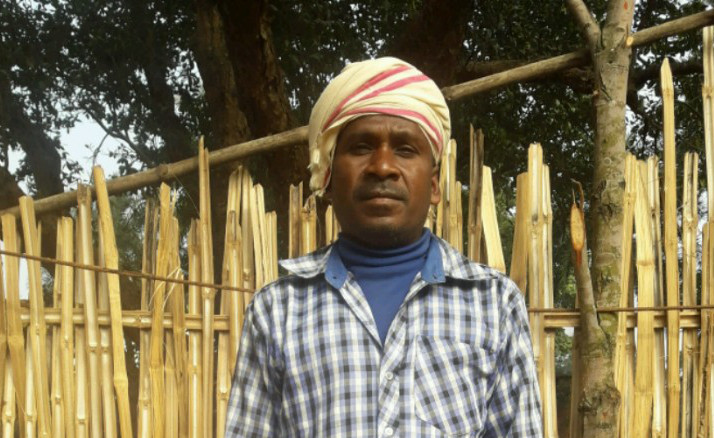Binay Dineshwar Dehri, a 45 years old Mal Pahari adivasi peasant, came from Dumka district, Jharkhand to participate in the Kisan Mukti Sansad. Binay Dineshwar Dehri’s household is a semi-proletarian household with a hand-to-mouth existence. They have received no government support for improving their land, for obtaining improved inputs or getting any formal-sector credit. They depend on usurious loans from traders for cultivating the small amount of forest land that they have. With lack of access to modern inputs, technology and funds for investment, productivity is low and agriculture gives them meagre returns. Binay said, “instead of providing incomes, farming in adivasi areas makes us incur losses, which in turn forces us to take loans”.

Binay Dineshwar Dehri, a 45 years old Mal Pahari adivasi peasant, came from Dumka district, Jharkhand to participate in the Kisan Mukti Sansad. Binay Dineshwar Dehri’s household is a semi-proletarian household with a hand-to-mouth existence. They have received no government support for improving their land, for obtaining improved inputs or getting any formal-sector credit. They depend on usurious loans from traders for cultivating the small amount of forest land that they have. With lack of access to modern inputs, technology and funds for investment, productivity is low and agriculture gives them meagre returns.
Situated in the north-eastern part of Jharkhand, Dumka district lies in the Santhal Pargana division and is mainly inhabited by adivasis. Binay lives in a village called Kundapahari in the Gopikander block of Dumka district. Kundapahari, a village inhabited by about 100 households, is situated on the bank of Banslai river. There are three settlements in the village, of which one is inhabited by Mal Pahari adivasis and two by Santhal adivasis. There is a primary school and an anganwadi in the Mal Pahari settlement, and a middle school in the Santhal part of the village. There is a building of a health centre in the village, which is not functional. Nearest health services, bank and market are in Amrapara, which is about 10 kilometers away. According to Census 2011, of a total of 567 hectares of the land of Kundapahari, about 66 per cent area is covered with forests.
Binay is a poor adivasi peasant with a large household of 19 members. The household includes his aged parents, his family, his brother’s family and his younger sister’s family. Binay and his brother-in-law work on the land as well as do wage labour for their livelihood. His elder brother, who worked as a panchayat sevak in the past, is now too old to work. Women in the household do the domestic work and participate in agricultural activities on the land.
The household cultivates about 4 acres of forest land for which they have not received any patta. The land is rocky, undulating and unirrigated. It can be cultivated only in the kharif season. Last year, the household cultivated green cowpea beans (barbatti) in about 2 acres. On rest of the land, they planted a mix of various grains. Sowing was done by broadcasting a mix of seeds of maize, bajra, tur and kulthi. The household has no money to buy seeds or fertilisers. They do not have much manure either. Soil is not very fertile and a part of it has to be left fallow every year to sustain its fertility. Binay reported that production of grain is not sufficient for their household’s consumption needs. In the last kharif season, they got about 6 quintals of barbatti, 5 quintals of maize and 1 quintal of bajra. Barbatti is produced mainly for selling in the haat which gives them some money to buy rice. Even though maize and bajra produced on the land is insufficient even for their own need, some distress selling of these grains is also required to meet other expenses. The grains are either sold to traders in the village or in the weekly haat.
Binay said, “instead of providing incomes, farming in adivasi areas makes us incur losses, which in turn forces us to take loans”. He told us that, given small quantity of produce, the household was unable to save grain for using as seed in the next season. As a result, they took seeds on loan from a trader. Such seed loans have to be repaid by giving 2.5 times the quantity of borrowed grain after harvest. The household also needs to borrow money from the trader, and these loans are also paid by providing grain to the trader, which is valued by the trader at a very low price. Dealings with the trader became doubly burdensome at the time of demonetisation as traders paid only Rs. 300 in new notes for every Rs. 500 that they should have paid.
Agriculture does not even provide for the household’s minimum subsistence requirements. After giving part of the produce to the trader in lieu of the borrowed seeds, the household’s net value of output of all crops produced on 4 acres of land was only Rs. 23,357.
Since agriculture does not provide them enough even for subsistence, Binay and his brother-in-law have to migrate to West Bengal in search of wage labour. Last year, they migrated for about 15-20 days in September, December and February. In West Bengal, they got work through a labour contractor and earned about Rs. 200 a day. In the past, they have also migrated to Gujarat and Mumbai.
Poor adivasi peasants like Binay Dehri have not benefited from technological developments that have swept Indian agriculture over the last five decades. In absence of any government support, agricultural output from the land is meagre and economic conditions of such poor peasants precarious.
** Vaishali Bansal is a Research Scholar at the Jawaharlal Nehru University, New Delhi.
This was originally published on NewsClick.in.
